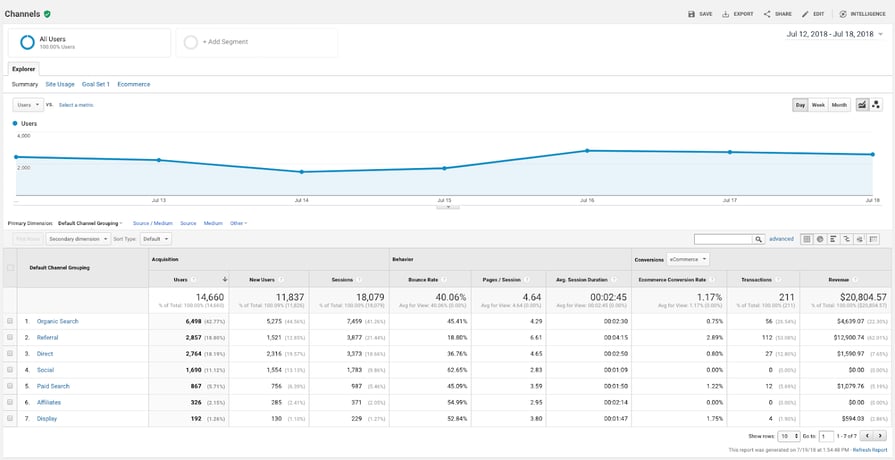When Does the Google Analytics Tracking Code Send an Event Hit to Analytics? A Deep Study Customer Communications
When Does the Google Analytics Tracking Code Send an Event Hit to Analytics? A Deep Study Customer Communications
Blog Article
Maximize Your Site Efficiency With Google Analytics Tracking Code
In the digital landscape, comprehending individual communications with your website is vital for optimization. This critical implementation not only notifies your choices yet also paves the method for an extra interesting user experience.
Understanding Google Analytics
Comprehending Google Analytics is crucial for site proprietors and online marketers aiming to enhance their on-line presence. This powerful tool gives essential understandings into individual actions, allowing stakeholders to make data-driven choices. By tracking numerous metrics, such as web page sights, bounce prices, and customer demographics, Google Analytics aids recognize which facets of an internet site are performing well and which require renovation.
One of the key attributes of Google Analytics is its capacity to section data. Customers can assess website traffic sources, user involvement, and conversion prices across various sections, such as geographical locations or tool kinds. This granularity enables online marketers to tailor their approaches to certain audiences, therefore improving the effectiveness of their projects.

Establishing Tracking Code
To harness the full possibility of Google Analytics, establishing the monitoring code properly is a fundamental action. The monitoring code, a bit of JavaScript, makes it possible for Google Analytics to gather data concerning user communications on your site. To start, log in to your Google Analytics account and browse to the Admin section. Under the Home column, pick "Tracking Details" and afterwards "Monitoring Code." Here, you will certainly find your special tracking ID, which begins with "UA-" adhered to by a series of numbers.
Following, you'll require to embed this code into the HTML of your web site. Preferably, place the monitoring code prior to the closing tag on every page you desire to check. If you're using a content management system (CMS) like WordPress, think about making use of plugins that assist in very easy combination.
After applying the code, it's crucial to verify its performance. Use the "Real-Time" records in Google Analytics to validate that information is being collected as expected. By guaranteeing appropriate configuration, you produce a solid foundation for efficient data analysis and calculated decision-making to improve your web site's efficiency.
Secret Metrics to Monitor
Routinely checking vital metrics in Google Analytics is essential for assessing your website's performance and customer involvement. Amongst the essential metrics to track are page views, which offer insight right into just how commonly individuals check out different pages on your site. In addition, one-of-a-kind site visitors assist you understand the reach of your content by showing the amount of unique users are involving with your website over a provided period.
Bounce price is one more crucial metric, disclosing the portion of visitors that leave your site after viewing just one page. A high bounce rate might signal concerns with material significance or individual experience. On the other hand, session duration shows for how long visitors remain on your website, assisting you evaluate web content efficiency and user passion.
Conversion rates are essential for determining the success of your website in attaining particular objectives, such as type entries or product purchases (when does the google analytics tracking code send an event hit to analytics?). Monitoring website traffic sources is additionally key, as it aids identify which networks drive one of the most traffic and conversions, enabling even more targeted marketing approaches
Analyzing Site Visitor Actions

In addition, tracking customer paths via the website assists disclose usual navigation patterns. This info is necessary in determining whether customers can easily discover the material they seek or if they run into obstacles that cause irritation. Identifying high exit pages can highlight locations that may need redesign or even more appealing web content to preserve visitors.
In addition, segmenting users based upon demographics, passions, and behavior supplies a deeper understanding of the target audience. This division enables services to customize content and advertising strategies better, enhancing the chance of conversions. Ultimately, examining site visitor behavior not only notifies internet site enhancements but likewise cultivates an extra user-centric approach, causing boosted satisfaction and loyalty gradually.
Applying Data-Driven Adjustments
Implementing data-driven changes is necessary for boosting internet site performance and achieving company goals. By leveraging insights gathered from Google Analytics, companies can determine locations for enhancement and make educated choices to maximize individual experience.
First, examine essential performance indicators (KPIs) such as bounce rates, session period, and conversion prices to identify certain problems influencing customer involvement - when does the google more information analytics tracking code send an event hit to analytics?. For example, a high bounce price on a touchdown web page might show that the web content is not reverberating with site visitors or that the page takes too long to load

Final Thought
In conclusion, the implementation of Google Analytics tracking code is vital for enhancing site performance. By precisely keeping track of user behavior and key metrics, valuable understandings can check these guys out be obtained, promoting data-driven decision-making.
By tracking numerous metrics, such as web page sights, bounce rates, and user demographics, Google Analytics assists determine which internet aspects of a site are performing well and which require improvement.
Users can analyze traffic resources, individual interaction, and conversion rates throughout various sections, such as geographic areas or gadget types. The monitoring code, a fragment of JavaScript, allows Google Analytics to collect information regarding individual interactions on your internet site.Regularly checking crucial metrics in Google Analytics is vital for evaluating your website's efficiency and user involvement. By leveraging Google Analytics, web site owners can get important insights right into how customers communicate with their website.
Report this page